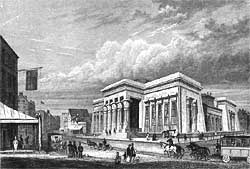Shyster
Q From Annie Grieshop; a related question came from Morandir Armson: In a recent online discussion about singing masters and hymn-book salesmen of the 19th century, the word shyster was used to describe certain members of that fraternity. Someone objected to the term as anti-Semitic. And now, of course, all sorts of opinions and etymologies are popping up. Would you be so kind as to clarify the term’s history for us?
A The supposed anti-Semitic origin links the word to the name of the vengeful money lender Shylock in Shakespeare’s Merchant of Venice, with the occupational ending -ster added. This is untrue. It is also often claimed to come from the name of a New York lawyer named Scheuster; in the 1840s, his unscrupulous ways are said to have so annoyed Barnabas Osborn, the judge who presided over the Essex Market police court in that city, that he supposedly began to refer to Sheuster practices. No such lawyer has been traced and it’s clearly just a folk tale. Unsuccessful attempts have also been made to link it to a Scots Gaelic word and to bits of English slang.
Whatever its origin, we use shyster to mean a person who uses unscrupulous, fraudulent, or deceptive methods in business. Historically, it has mainly been applied to lawyers. There’s good reason for that, as Gerald Cohen discovered when he traced its true origin some 25 ago. Professor Cohen found that shyster appeared first in the New York newspaper The Subterranean in July 1843, at first in spellings such as shyseter and shiseter but almost immediately settling down to the form we use now.

The Tombs prison
The background is the notorious New York prison known as the Tombs. In the 1840s it was infested by ignorant and unqualified charlatans, who pretended to be lawyers and officers of the court. Before shyster came into being, pettifogger was the usual term for them, a word of obscure origin for lawyers of little scruple or conscience that dates from the sixteenth century. Mike Walsh, the editor of The Subterranean and the first user of shyster, summed up these plaguers of the Tombs in this passage:
Ignorant blackguards, illiterate blockheads, besotted drunkards, drivelling simpletons, ci-devant mountebanks, vagabonds, swindlers and thieves make up, with but few exceptions, the disgraceful gang of pettifoggers who swarm about its halls.
Mike Walsh described shyster as both obscene and libellous. The circumstances surrounding its first appearance suggest that in New York underworld slang it was a term for somebody incompetent, so a potentially libellous description, and that only later — largely through the publicity that Walsh gave it in his newspaper in the years 1843-1846 — did it come to refer specifically to a crooked lawyer.
Professor Cohen concluded the word derives from German Scheisser for an incompetent person, a term known in New York through the many German immigrants there. Mike Walsh considered it obscene because it derives from Scheisse, shit, through the image of an incontinent old man. This is plausible, because British slang at the same period included the same word, meaning a worthless person; the usual spelling was shicer, though it appeared also as sheisser, shiser and shycer. It’s recorded first in print in Britain in 1846, but must be significantly older in the spoken language. (It was taken to Australia and from the 1850s was used there for an unproductive gold mine.) It may have been exported to New York by London low-lifers.
